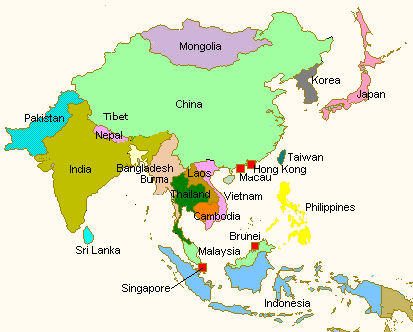Asia Map and General Asia Information
East Asia is going through the most dramatic political, economic and social changes in the world today.
Population
With approximately two billion people, East Asia is one of the
most heavily populated areas of the world. The distribution, however, is very uneven, with low density in the mountainous and desert areas of South and West China and Mongolia, contrasted with the very densely populated island of Java.
Ethnically it is equally diverse, with Turkic people living in the north-west, Mongoloid groups mainly in China and mainland South-East Asia, and Malayo-Polynesian in the archipelagos in the south-east.
Having shaken off the effects of colonialism and of the Second World War, East Asian nations established their independence and identity in the 1960s and 1970s, and are now becoming major players in the political and economic world scene.
Religions
There are four major religious groupings in East Asia: Chinese religion (Confucianism and Taoism) is practiced among many Chinese; Buddhism is found in most parts of East Asia, notably Thailand, Burma, Cambodia, Laos, Vietnam and Japan. Islam came to Asia in the 12th century, and is now the predominant religion in Indonesia, Malaysia and Brunei, whereas Christianity is the majority religion in the Philippines [mostly Roman Catholic and mixed with animism], but is practiced by minorities in most other countries as well. Other religions include animism, Hinduism, Shinto, shamanism, Sikhism and many cults. Communism has eroded much of the foundations of these religions, but today it is materialism which seems to be winning the battle for the souls of people.

The ethnic diversity in East Asia is reflected in the range of languages found there. Around 2500 ethno-linguistic people groups have been identified. Mandarin is spoken by around one billion people. Other languages are confined to a few thousand people.
Climate
This is as varied as the surface configuration, ranging from the hot and humid tropical areas in the south to the harsh desert climates in Mongolia. The monsoon wind brings heavy rainfall to most parts of South-East Asia, in contrast to Central Asia, which is dry for most of the year. Coastal regions are subject to destructive typhoons.
Geography
The topography is varied and includes the world’s highest mountains, in the Tibetan plateau, the world’s largest archipelago; Indonesia, the Gobi desert, the Mekong Delta and large but significantly diminished areas of rainforest. To the east of the Philippines, in Micronesia, is the Mariana Trench, the lowest region on the earth’s surface and the deepest part of the sea floor.
Huge rivers like the Yangtze, Yellow River, Mekong and Irrawaddy flow through the mainland, providing fertile alluvial soil to the vast plains. Deposits from a chain of volcanoes have had the same effect on the islands of the south-east. The mountainous areas of Central Asia and the Mongolian plateau are very arid and difficult to cultivate.
History
Some of the earliest known civilizations were based in North China. They were agricultural societies that used advanced social and political structures to maintain irrigation and flood-control systems.
From 200BC to 200AD, ambitious emperors from the Han dynasty spread Chinese hegemony over large parts of East Asia. As their empire declined, waves of Turkic, Mongol and Hunnish invaders swept across many areas of Central and East Asia. From the seventh century to the 15th, two forces dominated Asian events: the spread of the new religion of Islam and the expansion of the Mongols, who conquered much of Asia and threatened Europe. During that time, smaller empires like the Japanese, Korean, Thai and Khmer, and different Chinese dynasties came and went.
By 1500, Islam had gained a strong foothold in South-East Asia. Then, as many of these empires disintegrated, Europe’s new national states entered an era of exploration and colonialism. By the mid-19th century, much of East Asia was in the hands of the British, French, Dutch, Portuguese, Spanish and Russians. These powers exploited local resources and invested in plantations. Road and railroad systems aided transport and commerce, but most of the profits went abroad.
This exploitation led to conflicts, and the 20th century saw nation after nation fighting for and gaining independence from Western colonial powers. Many of these newly independent nations were then caught up in the rivalry of the Cold War of the 1960s and 1970s. But the emergence of Japan, Korea and Taiwan as major industrial powers and of Hong Kong and Singapore as world centers for trade and commerce triggered a wave of assertiveness and rapid economic growth.


